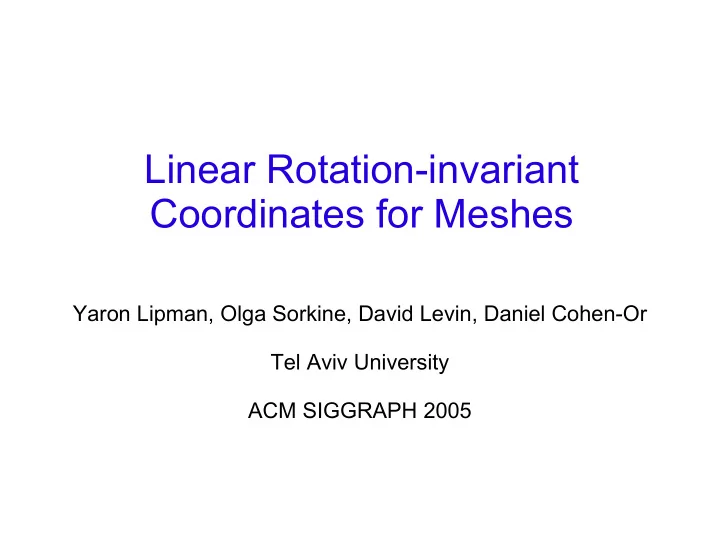

Linear Rotation-invariant Coordinates for Meshes Yaron Lipman, Olga Sorkine, David Levin, Daniel Cohen-Or Tel Aviv University ACM SIGGRAPH 2005
Outline ● Motivation – What's the problem, anyway? – Some approaches ● Multiresolution methods ● Local frames ● Method – Discrete differential forms ● Results
Problem ● Mesh requires local deformations ● Macro changes must preserve micro detail ● Deformations must be smooth and “intuitive” – Preserve distance, area, curvature etc as far as possible ● Interactive process: select a handle and transform it – the rest of the model should follow
Previous work ● Multiresolution methods – Break up model into various levels of detail – Transform one level while keeping others invariant ● Zorin et al. '97 ● Kobbelt et al. '99 ● Guskov et al. '99 ● Botsh and Kobbelt '04 – Problem: requires manual setting of level thresholds
Previous Work ● Preserve differential properties – Explicit thresholding not required – One approach: consider global coordinates but ensure that local frames are correctly updated ● Implicitly include local frame data in Laplacian fitting scheme [Sorkine et al. 2004] ● Propagate user-defined transformation of “handle” [Yu et al. 2004, Zayer et al. 2005] ● Heuristically approximate local rotations [Lipman et al. 2004] – Problem: local quantities not rotation invariant, so patches must be... umm... patched
We need... ● A way to store the mesh that is invariant under all rigid transformations ● Why? Wrong – When a joint is bent, the limbs (pseudo-rigid) should preserve their properties although their spatial orientation has changed ● So global coordinates, in fact anything that stores absolute or relative position vectors , are out Right
Example: disaster recovery Ideally, we shouldn't need this
Discrete forms
Discrete forms Parametrization 1 st and 2 nd forms Also to store direction of normal
Discrete forms ● First DF – geometry in tangent plane – quadratic in each triangle – C 0 continuity between adjacent triangles ● Second DF – geometry perp. to tangent plane – linear (“height above tangent plane”) ● The coefficients (DFC's) depend on: ● vertex angles ● edge lengths – This is nice – preserve these quantities and you're likely to preserve size, curvature etc
Key Point #1: Local Reconstruction ● The geometry at each vertex (upto a rigid transformation) can be computed from the discrete form coefficients ( g k,k , g k,k+1 , L k , O k ) – locally, we can compute: ● the neighbours of a vertex ● the normal at the vertex – Basic idea: fix the vertex, an edge incident on it, and the normal (rigidity); now generate neighbours successively x 1 x 2 x 3 ... g 11 , g 12 , g 22 , g 22 , g 23 , g 33 , L 2 , O 1 L 3 , O 2
Key Point #2: Global Reconstruction ● Discrete form coefficients uniquely define the entire mesh (again upto a RT) ● Basic idea: discrete surface equations: – Now dealing with b 1 , b 2 , N , not direct vertex geometry, but the two are equivalent
Key Point #2: Global Reconstruction ● The coefficients in the discrete surface eqns are functions of the DFC's ● How? – the eqns express one frame in terms of an adjacent frame – local frame at one vertex, by construction, has info about neighbours – do some algebra and voila!
Key Point #2: Global Reconstruction ● Put all disc. surface eqns together to get a ● huge, ● overdetermined ● sparse ● linear system in b 's and N 's ● Solve to get local frame at each vertex ● Could fix a vertex, generate its neighbours, and branch out until all vertices are covered. But this amplifies errors.
Key Point #2: Global Reconstruction ● Better: if the frame of vertex i has been determined, then the tangent-plane projections of all its neighbours can be found: , and cyclically generate others ● Now set up another linear system as: ● Solve this to get the vertex positions
Back to deformations... ● Observe: surface eqns form linear system, and so do the position difference eqns. ● Add constraints on frames and positions as required: – Linear transformation (e.g. rotation, scale): surface (frame) eqns – Translation: position eqns ● Now overdetermined augmented system may not have a solution!
Deformations ● Get least squares solutions of linear systems (recall: construct normal eqns: Ax = B A T Ax = A T B ) ● This usually does the job, assuming deformations are not too large
More examples
More examples 170 o 3 Steps to 315 o Sharp edges are preserved
Connections ● Differential geometry: fundamental forms – first – second ● Characterize tangential and normal properties ● Approximate local reconstruction – Bonnet theorem ensures surface can be reconstructed given the fundamental forms which hold Gauss-Codazzi-Mainardi conditions – Two stages: i) changes in local frames, ii) frames are integrated
Connections ● Given k g (geodesic curv.), k n (normal curv.), t r (relative torsion) and a curve parametrized by s : ● Compare with discrete surface eqns ● So at least intuitively, this method preserves the curvature quantities as much as possible
Recommend
More recommend